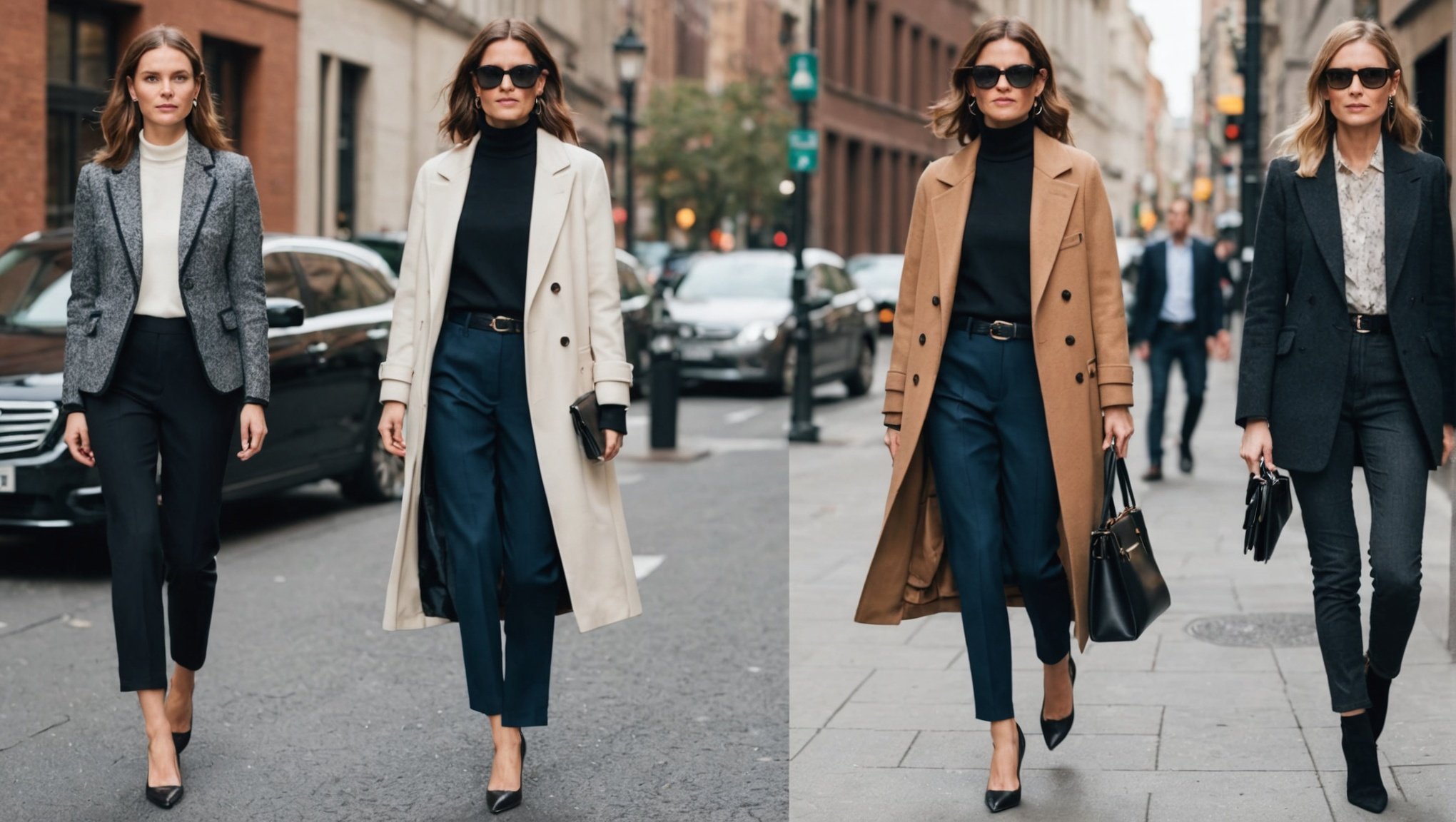Layering is not just a fashion strategy; it’s an art form that transforms your look and mood. Shifting from office attire to evening elegance can feel daunting, but with the right techniques, it becomes seamless. Whether you’re heading to a dinner with clients or meeting friends, mastering this skill ensures you always dress for success. Discover practical tips to elevate your style while maintaining comfort and versatility. Embrace a wardrobe that adapts effortlessly to your day-to-night needs.
Understanding Layering Basics
Layering techniques are crucial in modern fashion for creating versatile outfits that transition seamlessly from professional to evening wear. The importance of layering lies in its ability to add depth and dimension to an outfit, allowing for a more personalised and adaptable style. By mastering the art of layering, individuals can effortlessly switch between different looks without needing a complete wardrobe change.
Additional reading : Illuminate Your Evening Attire: Stylish Ways to Integrate Reflective Materials for Safety and Elegance
The key principles of effective layering involve understanding the balance between different textures, weights, and colours. Start with a base layer that is comfortable and fits well, then build upon it with complementary pieces. This could include adding a structured blazer for a professional look, which can later be swapped for a more relaxed cardigan or jacket for evening wear.
Benefits of mastering layering include increased wardrobe versatility, allowing for creative expression and practicality in varying weather conditions. It also enables a smooth transition between different social settings, making it easier to adapt your style throughout the day. By focusing on these principles, you can enhance your fashion sense, ensuring that each layer complements the next while maintaining a cohesive and stylish appearance. Embrace layering to transform your wardrobe into a collection of adaptable and chic ensembles.
Also read : Revamp Your Modern Wardrobe: The Art of Incorporating Vintage Belts
Essential Layering Pieces
When it comes to layering, having the right wardrobe staples is key to creating versatile outfits. These layering essentials form the backbone of any adaptable wardrobe, allowing for seamless transitions between different styles and settings.
A well-chosen blazer is a must-have item. It adds structure and sophistication, making it ideal for professional environments. Opt for neutral colours like black, navy, or grey to ensure it complements various outfits. For a more relaxed look, consider swapping the blazer for a cardigan. Cardigans offer comfort and warmth, and they come in a variety of styles, from long and flowy to cropped and fitted.
Vests are another versatile clothing option. They can be worn over shirts or under jackets, providing an additional layer without adding bulk. Look for lightweight materials like cotton or wool blends for year-round wear.
Lightweight outerwear, such as denim jackets or trench coats, plays a crucial role in layering. These pieces are perfect for transitional weather, offering just the right amount of coverage. Choose styles that can be easily dressed up or down, ensuring they fit well with both casual and formal ensembles. By incorporating these essentials, you can build a flexible and stylish wardrobe.
Fabric Choices for Layering
Selecting the right layering fabrics is essential for achieving both comfort and style. The choice of fabric types can significantly impact the overall look and feel of an outfit, especially when transitioning between seasons.
When it comes to seasonal materials, lightweight cotton and linen are ideal for spring and summer. These fabrics are breathable, ensuring you stay cool and comfortable. For autumn and winter, opt for wool or cashmere, which provide warmth without compromising on elegance. Wool blends are particularly versatile, offering the benefits of wool with added softness and flexibility.
Mixing and matching textures can enhance your layered look. Consider combining smooth fabrics like silk with rougher textures such as tweed or denim. This contrast not only adds visual interest but also depth to your outfit. When layering, balance is key—avoid overwhelming your look with too many heavy fabrics.
Here are some tips for choosing fabrics:
- Prioritise comfort: Ensure the base layer is soft against the skin.
- Consider the occasion: Select fabrics that suit the setting, whether casual or formal.
- Adapt to the weather: Use lighter fabrics in warm climates and heavier ones when it’s cold.
By understanding fabric choices, you can master layering with confidence.
Colour Coordination Strategies
Navigating the world of colour coordination can transform your wardrobe into a harmonious and visually appealing collection. Understanding the colour wheel is essential for effective outfit planning. The wheel helps identify complementary colours, which are opposite each other and create a striking contrast. For example, pairing blue with orange or red with green can make your outfit pop.
To select colours that transition well from day to night, consider using a neutral base. Neutrals like black, white, or grey can be paired with bolder hues for a versatile look. During the day, you might opt for a pastel top with a neutral base, transitioning to a deeper, richer shade for evening wear.
Here are some examples of colour combinations that work well:
- Day to Night: Light blue with navy and white accents
- Professional to Casual: Olive green with mustard and beige
- Seasonal Transition: Coral with teal and cream
By mastering these strategies, you can create outfits that are not only stylish but also adaptable to various settings and times of day. Embrace the art of colour coordination to elevate your fashion game.
Accessorizing Your Layers
Accessorizing is a transformative tool in the world of fashion, allowing you to elevate your layered outfits with minimal effort. Layering accessories can enhance any ensemble, adding personality and flair while offering practical benefits.
The importance of accessories lies in their ability to transform an outfit. A simple scarf or a statement necklace can shift your look from casual to sophisticated in seconds. Accessories like belts can define your silhouette, adding structure and polish to layered garments. Incorporating a hat or a pair of sunglasses can inject a touch of glamour or mystery, making your style more dynamic and versatile.
For a polished look, consider these recommended accessories:
- Scarves: Opt for silk or wool for texture contrast.
- Jewellery: Choose bold pieces to add interest.
- Belts: Use to cinch waists and add definition.
- Hats: Perfect for adding character and style.
To effectively use accessories to shift styles, start by identifying the focal point of your outfit. Use accessories to highlight this area, ensuring they complement the overall look. By thoughtfully selecting and positioning your layering accessories, you can effortlessly adapt your style to suit any occasion.
Practical Tips for Office to Evening Transition
Navigating the shift from a professional environment to an evening setting can be seamless with the right outfit transition tips. The key lies in style adaptation, allowing you to effortlessly move from office to after-work events.
Quick changes are essential for a smooth transition. Consider swapping a structured blazer for a more relaxed cardigan or adding a statement necklace to elevate your look instantly. These styling tricks can transform your ensemble without requiring a complete outfit change.
For example, an outfit that works for both settings might include a tailored dress paired with a lightweight jacket. During office hours, keep the look polished with closed-toe shoes and minimal jewellery. As the day progresses, switch to bold accessories and a pair of stylish heels to adapt your style for the evening.
Another effective combination is a fitted blouse with wide-leg trousers. In a professional setting, maintain a refined appearance with a sleek belt and classic pumps. Transitioning to a casual evening event can be as simple as adding a colourful scarf or swapping pumps for chic flats.
By mastering these outfit transition tips, you can ensure your style remains versatile, sophisticated, and ready for any occasion.
Visual Examples of Layered Outfits
Understanding the art of layering can be greatly enhanced by examining outfit inspiration through visual examples. These examples serve as a guide to crafting layered looks that are both functional and stylish. Visual styling plays a crucial role in helping individuals grasp the nuances of combining different garments and textures.
One successful layered look might include a lightweight turtleneck paired with a sleeveless dress, topped with a structured blazer. This ensemble not only provides warmth but also adds depth and sophistication. For a more casual approach, consider a long cardigan over a simple tee and jeans, finished with a denim jacket for an effortlessly chic appearance.
To recreate these looks with personal flair, focus on incorporating unique accessories or experimenting with colour combinations that reflect your style. For instance, adding a vibrant scarf or bold jewellery can transform a classic outfit into something uniquely yours.
When drawing inspiration from visual examples, pay attention to the balance of proportions and textures. Mixing smooth fabrics with textured ones can create a dynamic and engaging look. By observing and adapting these layered looks, you can develop a wardrobe that is versatile, fashionable, and truly personalised.
Common Layering Mistakes to Avoid
Layering can elevate your style, but it’s easy to fall into layering pitfalls that compromise the look. One frequent outfit error is over-layering, which can lead to bulkiness. To avoid this, focus on selecting pieces that complement each other in texture and weight. Opt for thin, breathable fabrics as base layers, and gradually build up with thicker materials.
Another common mistake is neglecting proportion. A well-balanced silhouette is crucial; ensure that your layers do not overwhelm your frame. For instance, pair a bulky top with slim-fitting bottoms to maintain harmony. Avoid excessive use of oversized garments, as they can add unnecessary volume.
Discomfort is another issue when layering. To prevent this, choose fabrics that allow for movement and breathability. Avoid synthetic materials that trap heat and moisture, leading to discomfort. Instead, opt for natural fibres like cotton or wool that provide warmth without sacrificing comfort.
Here are some style advice tips:
- Limit layers to three or four to keep the look sleek.
- Balance bulk: Mix loose and fitted pieces.
- Prioritise comfort: Choose breathable fabrics.
By being mindful of these layering pitfalls, you can create outfits that are both stylish and comfortable.
Seasonal Layering Techniques
Adapting layering by season is essential for maintaining comfort and style throughout the year. Different seasons call for specific seasonal fashion techniques to ensure your outfits are both practical and chic.
In spring, focus on lightweight layers such as cotton shirts and cardigans. These pieces are perfect for fluctuating temperatures, allowing you to add or remove layers as needed. Summer calls for breathable fabrics like linen, which keep you cool while adding texture to your look. Consider sleeveless tops or light scarves for added versatility.
As autumn approaches, incorporate warmer materials like wool or cashmere. A layered outfit might include a long-sleeve shirt under a vest, topped with a trench coat. This combination provides warmth and style without being overly bulky. In winter, layering becomes crucial for insulation. Start with thermal layers, then add sweaters and a heavy coat to combat the cold.
When adjusting outfits for weather changes, consider climate considerations. For unpredictable weather, keep a compact umbrella or a packable jacket on hand. By understanding these seasonal layering techniques, you can tailor your wardrobe to suit any climate, ensuring comfort and elegance year-round.
Building a Versatile Layered Wardrobe
Creating a versatile wardrobe involves selecting wardrobe essentials that serve as the foundation for a wide range of outfits. This strategy not only enhances your style but also ensures a long-term investment in fashion.
Focus on quality over quantity when curating your wardrobe. Investing in high-quality pieces like a classic trench coat or a well-fitted blazer can pay off in the long run. These items are timeless and can be layered with various outfits, allowing you to express your personal style while adapting to different occasions.
To maintain and update your wardrobe over time, regularly assess your collection. Identify pieces that are worn out or no longer fit your style, and replace them with versatile fashion items that can easily integrate into your existing wardrobe. This approach keeps your collection fresh and adaptable without needing frequent overhauls.
Here are some tips for a versatile wardrobe:
- Invest in quality staples that last.
- Regularly review your wardrobe to ensure it reflects your current style.
- Mix and match pieces to explore new combinations.
By focusing on these strategies, you can build a layered wardrobe that is both adaptable and enduring.













